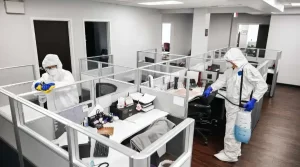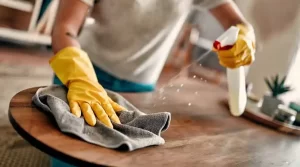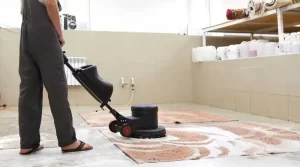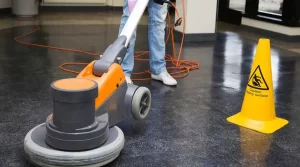Consider how much time you spend with your electronic devices, such as computers, keyboards and mouse, copiers and printers, phones, and headsets. We utilize them all the time in our personal and professional lives.
It is more crucial than ever to disinfect electronic equipment, particularly given the enormous effect of COVID-19. JM Nashville Commercial Cleaning’s specialists will teach you all you need to know about cleaning and sanitizing electronic equipment safely and efficiently in this thorough guide.
Why is it critical to clean and disinfect electronic equipment?
Electronic equipment is a crucial source of germs and pathogens. Studies have shown that keyboards, mouse, and other workplace equipment may be up to ten times dirtier than a toilet seat! With all of the time we spend using electronic devices, it’s no surprise that so many people become sick each year from avoidable ailments like the cold and flu. Cleaning is extremely critical in light of the epidemic.
(1) Cleaning and sanitizing electronic equipment is crucial for two reasons: preventing the transmission of disease-causing bacteria and protecting the device from harm. Dust, filth, and grime may accumulate on electrical equipment over time, leading it to malfunction or break down altogether. Extend the life of your electronic equipment and keep it running correctly by cleaning and sanitizing it regularly.
What chemicals are safe for electronics?
Many cleansers and disinfectants claim to be safe for electronics. They are not, however, all created equal. Because certain cleaners may potentially harm electronic equipment, so it’s critical to choose one mainly intended for cleaning it.
Isopropyl alcohol, usually known as rubbing alcohol, is a popular and efficient disinfectant for electronic devices.
(2) This disinfectant is safe on most electronic devices and is very efficient in killing germs and bacteria. To achieve the greatest results, use an isopropyl alcohol disinfectant that contains at least 70% alcohol.
Hydrogen peroxide is another safe and efficient disinfectant for electronics. Because it is so powerful at destroying germs and bacteria, this disinfectant is often used in hospitals and other medical environments. To obtain the greatest results, use a hydrogen peroxide disinfectant with a concentration of at least 3%.
Procedures to follow before cleaning and sanitizing electronic equipment
- First, thoroughly wash your hands with soap and water to eliminate dirt or germs.
- Unplug any electronic devices from power outlets. When cleaning a computer, keyboard, or mouse, switch it off and unhook it from the computer.
- Remove any batteries from electrical devices. Cleaning chemicals may harm batteries, so remove them before cleaning.
- Gather all the items you’ll need, such as disinfectant wipes or spray, gloves, and a microfiber cloth.
- Make sure the location where you’re working is well-ventilated.
- Take the electrical devices outdoors if at all feasible. This will assist to avoid any toxic chemicals or fumes from harming the equipment.
- Tape any exposed circuits or electrical components. This will prevent them from injury as you clean and disinfect them.
How to clean and disinfect a computer display, keyboard, and mouse
Disinfecting monitor:
- Wipe the monitor with a disinfectant wipe or spray a disinfectant onto a microfiber cloth and wipe the screen. Avoid getting any cleaner on the bezel (the frame around the screen).
- Remove any cleaning from the bezel with a clean, dry microfiber towel.
- Polish the screen using a glass cleaner and dry microfiber cloth.
Disinfecting keyboard:
- Shake the keyboard upside down to eliminate any loose dirt or particles.
- Wipe off the keys with a disinfectant wipe or spray a disinfectant onto a microfiber cloth. Make careful to go between the keys.
- Remove any with a clean, dry microfiber cloth. Cleaning that has gotten on the keys.
- Polish the keys using a glass cleaner and dry microfiber cloth.
- Taking the keys out is usually not a smart idea. However, removing the keys is simple if it’s secure and you want to go the additional mile. Turn the keyboard upside down and shake it. Carefully clear any dirt or debris that may be loose before prying the keys up with a flathead screwdriver or a similar tool, disinfecting them with a disinfectant wipe or spraying them with a disinfectant, and allowing them to air dry.
Disinfecting mouse:
- Wipe the top of the mouse with a disinfectant wipe or spray a disinfectant into a microfiber cloth and wipe it off.
- Clean any dirt or debris between the buttons using a cotton swab or toothpick.
- Remove any cleaning that may have gotten on the mouse with a clean, dry microfiber cloth.
- Polish the mouse using a glass cleaner and dry microfiber cloth.
How to clean and disinfect copiers and printers
Disinfecting copier:
- Please turn off the copier and unhook it from the power supply.
- Take any paper out of the copier.
- Open all of the copier’s doors and compartments to access all the surfaces that need to be cleaned.
- Wipe all surfaces with a disinfectant wipe, or spray a disinfectant onto a microfiber cloth and wipe it down. Cleaning the control panel, touch screen, buttons, and other surfaces that come into contact with your hands is essential.
- Clean any dirt or debris between the keys or buttons using a cotton swab or toothpick.
- Remove any cleaner that has gotten on the copier using a clean, dry microfiber cloth.
- Use a glass cleaner and a dry microfiber cloth to polish all surfaces.
- Restart the copier and reconnect it to the power supply.
Disinfecting printer:
- Turn off the printer and unhook it from the power socket.
- Remove any paper from the printer.
- Open all of the printer’s doors and compartments to access all surfaces that need cleaning.
- Wipe down all surfaces with a disinfectant wipe or spray a disinfectant into a microfiber cloth and wipe it down. Make care to wipe the control panel, touch screen, buttons, and other surfaces that come into contact with your hands.
- Clean any dirt or debris between the keys or buttons using a cotton swab or a toothpick.
- Clean up any with a dry, clean microfiber cloth. Cleaning that has gotten on the printer.
- Polish all surfaces using a glass cleaner and dry microfiber cloth.
- Restart the printer and reconnect it to the power source.
How to clean and disinfect phones and headsets
Disinfecting phones:
- Turn off your phone.
- Remove the battery (if feasible) and SIM card.
- Wipe down all surfaces with a disinfectant wipe or spray a disinfectant into a microfiber cloth and wipe it down. Make careful to wipe the screen, buttons, and any other surfaces that come into touch with your hands.
- Utilize a cotton swab or a toothpick to remove any dust or debris from in between the keys or buttons.
- Remove any cleaner that may have gotten on the phone using a clean, dry microfiber cloth.
- Using a dry microfiber cloth and glass cleaner, polish all surfaces.
- Turn on the phone and replace the battery, if possible.
Disinfecting headsets:
- Turn off the headset.
- Remove the battery (if possible).
- Wipe down all surfaces with a disinfectant wipe or spray a disinfectant into a microfiber cloth and wipe it down. Make care to clean the earpieces, buttons, and other surfaces that touch your skin.
- Utilize a cotton swab or a toothpick to remove any dust or debris from in between the keys or buttons.
- Remove any cleanser that may have gotten on the headset using a clean, dry microfiber towel.
- Polish all surfaces using a glass cleaner and dry microfiber cloth.
- Replace the battery (if feasible) and power on the headset.
How to clean and disinfect a laptop
Disinfecting the exterior:
- Wipe the monitor with a disinfectant wipe or spray a disinfectant onto a microfiber cloth and wipe the screen. Avoid getting any cleaner on the bezel (the frame around the screen).
- Wipe down the keyboard with a disinfectant wipe or spray a disinfectant onto a microfiber cloth. Make careful to go between the keys.
- Wipe down the touchpad with a disinfectant wipe or spray a disinfectant into a microfiber cloth and wipe it down.
- Remove any cleanser that may have gotten on the display, keyboard, or touchpad using a clean, dry microfiber cloth.
- Polish the screen using a glass cleaner and dry microfiber cloth.
- Polish the keyboard using a glass cleaner and dry microfiber cloth.
Cleaning the interior:
- Blow any dust or dirt out from between the keys using compressed air.
- Wipe down the keyboard with a disinfectant wipe or spray a disinfectant onto a microfiber cloth. Make careful to go between the keys.
- Wipe down the touchpad with a disinfectant wipe or spray a disinfectant into a microfiber cloth and wipe it down.
- Clean any dirt or debris between the buttons using a cotton swab or toothpick.
- Remove any cleaner that may have gotten on the keyboard or touchpad using a clean, dry microfiber cloth.
- Polish the keyboard using a glass cleaner and dry microfiber cloth.
Is UV light adequate for disinfecting electronic equipment?
UV light disinfection is a common approach for sanitizing electronic devices. However, there is no scientific proof that UV light disinfection efficiently kills germs and bacteria. Several studies have shown that UV radiation may harm electronic devices. (3)
If you decide to utilize UV light disinfection, apply it correctly. First, disconnect the item from any power source. Next, put the UV light at least six inches away from the device. Please turn on the UV light and let it disinfect the equipment for at least two minutes. After disinfection, ensure the equipment is thoroughly dry before using or storing it.
What not to do when cleaning and disinfecting electronic equipment
When cleaning and sanitizing electronic equipment, you should avoid a few things.
- Use no cleaners or disinfectants that are not mainly developed for cleaning electronic equipment. These cleaners may harm the equipment.
- Submerge electrical devices in no liquids. This may harm the electronics and nullify any warranties.
- Use UV light disinfection on any electronic equipment with sensitive surfaces, such as LCDs. UV rays may cause harm to these surfaces.
- Avoid using strong chemicals, such as bleach, on electrical equipment. These substances may harm electronics.
- Do not use compressed air to clean electrical equipment. The pressurized air might drive dirt and dust into the apparatus, causing it to fail.
How often should electronic equipment be disinfected?
It is critical to disinfect electronic equipment regularly, mainly if numerous persons use it. However, if you utilize electronic equipment in a hospital context or someone unwell has used it, you should disinfect it more often.
If someone who uses the equipment becomes unwell, disinfect it as quickly as feasible. If the equipment touches body fluids such as blood or saliva, it should also be disinfected.
What are the benefits of regularly cleaning and disinfecting electronic equipment?
Cleaning and disinfecting electronic equipment on a regular basis may assist in avoiding the spread of sickness in the workplace. You can minimize the number of sick days taken by workers by cleaning the equipment. This, in turn, may assist in increasing workplace productivity and morale.
It also increases the life of your electrical devices. You can avoid dirt and dust on the equipment by disinfecting it regularly. Follow these steps to thoroughly clean and disinfect your electronic equipment.
Do you need Professional help?
JM Nashville Business Cleaning specializes in cleaning commercial premises and the most sensitive regions and equipment inside them. It is more crucial than ever for workers and consumers to feel comfortable and to prioritize disinfection. Remove the worry of attempting to handle it yourself or wondering whether your company is clean. Contact JM Nashville Commercial Cleaning for personalized service plans in 333 Union St. 305 Nashville, TN region.







